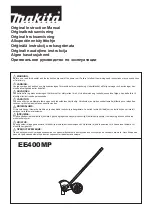
Exterior Projection 500 User Manual
31
●
Tighten cover screws exactly as directed in this manual and using a torque driver.
●
Make sure that all threads are clean and dry. Do not apply lubricant to threads before
assembly. While lubricant may make disassembly easier during future service, it means that
tightening screws to the specified torque will compress seals too much.
●
Air and water can be sucked along cables and into fixtures. A cracked or porous cable jacket
can allow water into the cable. Replace any cable that is not in perfect condition. Make sure
that cables from fixtures open into dry areas (e.g. junction boxes in dry locations).
●
Do not clean fixtures with high-pressure water jets or immerse them.
Seals and sealing surfaces
The fixture must be sealed effectively. Covers have silicone seals that will withstand rain and water
splashing but will not withstand immersion or high-pressure water jets. Reinstall covers and seals
carefully if you have removed them.
●
Make sure that seals and sealing surfaces are perfectly clean, dry and in perfect condition
before installing a cover. If you need to clean seals, use water and a soft cloth only. Replace
any seal that shows signs of aging, damage, cracking, stretching or deformation. Replacement
seals are available from Martin.
●
Reinstall seals in exactly their original position.
●
Install seals so that they closely follow the profile of the metal parts they are installed on.
When you run your finger around the sealing surface after you have installed a cover, you
should not be able to feel any places where the seal sticks out or sinks into the gap between
the sealing surfaces.
●
Do not use liquid gasket or any other type of sealant on sealing surfaces or seals.
Removing humidity using Evaporation Mode and silica gel desiccant
Each time you open the top cover, remove humidity from inside the fixture as directed in this
chapter before you close the fixture again. See ’Reinstalling the top cover’ on page 32.
Pressure relief valves
A valve with a Gore-Tex membrane on the back of the fixture (see ‘Fixture overview’ on page 9)
equalizes pressure by allowing air to pass through it when the fixture heats up and cools down, but
at the same time it acts as a barrier to water in liquid form. The expulsion of warm air (with a
slightly higher water vapor content) and intake of cool air (with a slightly lower water vapor content)
prevents humidity buildup over time, provided that the valve works correctly and the fixture is
correctly sealed.
Valves become blocked over time as the micropores in the membrane fill with particles. If a valve
becomes blocked by dirt or water, excess pressure can damage seals or cause air and even water
to be sucked into the fixture along cables. Valves cannot be cleaned and must be replaced if they
show any signs of contamination or if they are not in perfect condition.
To obtain the maximum service life from your fixture, follow these guidelines:
●
Do not allow water to collect on or near valves. Do not install a fixture with the valve
membrane horizontal so that water can pool on it.
●
Replace a valve with a new item if it shows any signs of contamination or is not in perfect
condition.
●
Replace valves after an extended period of use. Intervals for valve replacement depend on the
installation environment.
●
Consult your Martin dealer about a suitable valve replacement schedule. Contact Martin
Service for valve replacement
Summary of Contents for Exterior Projection 500
Page 1: ...Exterior Projection 500 User Manual...
Page 57: ......
Page 58: ......
Page 59: ......
Page 60: ...www martin com Olof Palmes All 18 8200 Aarhus N Denmark Tel 45 8740 0000 Fax 45 8740 0010...
















































